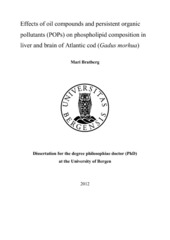| dc.contributor.author | Bratberg, Mari | en_US |
| dc.date.accessioned | 2012-12-17T11:03:26Z | |
| dc.date.available | 2012-12-17T11:03:26Z | |
| dc.date.issued | 2012-10-12 | eng |
| dc.identifier.isbn | 978-82-308-2114-5 | en_US |
| dc.identifier.uri | https://hdl.handle.net/1956/6234 | |
| dc.description.abstract | The work in this thesis is part of a project led by the Institute of Marine Research (IMR), with partners at the Department of Biomedicine (University of Bergen, UiB), the National Institute of Nutrition and Seafood Research (NIFES), and Department of Chemistry (UiB) financed by the Research Council of Norway. Fish in the North Sea experience exposure to xenobiotic compounds from historic pollution and releases from industry and other human activities. A number of adverse biological effects of persistent organic pollutants (POPs) have been shown, including alterations in the cell membrane. This study is a follow-up of a previously published study from IMR that showed that Atlantic cod (Gadus morhua) that were exposed to short-chained alkylphenols had altered lipid composition and fatty acid distribution in the liver and brain compared to un-exposed fish. The study in this thesis consists of two exposure experiments where Atlantic cod were given pollutants in the diet through 4 weeks. In experiment 1 Atlantic cod were exposed to para-substituted nonylphenols (NPs), either the straight-chained isomer 4-n-NP, or a mixture of branched isomers, 4- T-NP. In experiment 2 Atlantic cod were given crude oil and/or a mixture of halogenated POPs. The POPs included polychlorinated biphenyls (PCB), chlorinated pesticides, polybrominated diphenyl ether (PBDE) and perfluorooctanesulfonic acid (PFOS). The fish were given doses corresponding to chronic pollution or higher doses analogous to acute spill accidents. The main focus of the thesis has been detailed studies of lipid composition, with emphasis on the phospholipids in the membranes, and fatty acid distribution in membrane lipids. Toxicogenomic studies have also been performed on the transcriptional levels, as well as biophysical studies of model lipid membranes as Langmuir monolayers and their interactions with selected POPs. The treatments with NPs or oil/POPs did not induce large changes in membrane composition (lipid class composition and fatty acid distribution) in the liver and brain of male Atlantic cod. However, the transcriptional data suggest that the fish were affected by the treatment at the molecular level. Differential expression in selected genes in phase I and II metabolism of xenobiotic compounds, PL biosynthesis and antioxidant responses were shown. | en_US |
| dc.language.iso | eng | eng |
| dc.publisher | The University of Bergen | eng |
| dc.relation.haspart | Paper I: Bratberg , Mari., Liu, Li & Meier, Sonnich. (2012) Pitfalls in the use of polyethylene aminopropyl-coated columns for solid phase extraction separation of lipids. Full text not available in BORA. | en_US |
| dc.relation.haspart | Paper II: Bratberg, Mari., Olsvik, Pål A., Brekken, Hans Kristian., Vadla, Reidun & Meier, Sonnich. (2012) Effects of branched and normal isomers of para-substituted nonylphenols on the glycerophospholipids in the liver and brain of male Atlantic cod (Gadus morhua). Full text not available in BORA. | en_US |
| dc.relation.haspart | Paper III: Bratberg, Mari., Olsvik, Pål A., Edvardsen, Rolf B., Brekken, Hans Kristian., Vadla, Reidun & Meier, Sonnich. (2012) Effects of oil pollution and persistent organic pollutants (POPs) on glycerophospholipids in liver and brain of male Atlantic cod (Gadus morhua). Full text not available in BORA. | en_US |
| dc.title | Effects of oil compounds and persistent organic pollutants (POPs) on phospholipid composition in liver and brain of Atlantic cod (Gadus morhua) | en_US |
| dc.type | Doctoral thesis | |
| dc.description.version | publishedVersion | en_US |
| dc.rights.holder | Copyright the author. All rights reserved | |
